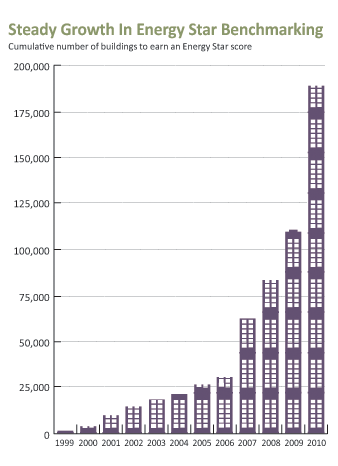Energy Star Offers New Ratings, Easier Benchmarking for Buildings
After more than 10 years, the U.S. Environmental Protection Agency's (EPA's) Energy Star Buildings program has become well established as a resource to help building owners and managers reduce energy use and improve their bottom lines. The Energy Star score — which shows how a building's energy use stacks up to comparable buildings on a 1 to 100 scale — is not only widely used by individual building owners, but also has been adopted by the LEED for Existing Buildings: Operations and Maintenance program and as part of mandatory local and state benchmarking and disclosure regulations. A variety of other factors — including customer demand for greener buildings, the widespread recognition of the value of Energy Star certification, and the availability of federal, state and utility incentives — has also led owners to take advantage of Energy Star's free tools and resources to measure, track, and improve building energy efficiency.
As well-known as the overall Energy Star Buildings program is, there are important elements of the program that many building owners may not be aware of. One reason for this is that EPA has continued to expand the program over the years. Consider the Portfolio Manager tool. As most building owners know, Portfolio Manager can be used to track and assess energy use within individual buildings as well as across an entire portfolio. All that is needed is to enter the building's energy consumption and facility characteristics into a Portfolio Manager account to benchmark building energy performance, assess energy management goals over time, and identify strategic opportunities for savings and recognition.
What is less well-known is that Portfolio Manager can also be used to track energy costs, water consumption and carbon emissions, increasingly important considerations for many building owners.
Energy Management
To help building owners get started quickly with Portfolio Manager, EPA has developed a Benchmarking Starter Kit. To provide another way to ease benchmarking with Portfolio Manager, EPA has partnered with automated benchmarking service providers. These service providers can offer customers the Energy Star's 1 to 100 energy performance rating for eligible buildings. That way, these customers don't have to manually upload their own energy data. Weather-normalized energy intensity and emissions inventories are also available for buildings that are not eligible for an Energy Star score.
In just five years, automated benchmarking services have experienced substantial growth, with 86 companies offering or planning to offer such services. During 2010, these services were responsible for more than 45 percent of all buildings benchmarked in the Portfolio Manager tool. From January through June 2011 alone, more than 12,250 new buildings representing approximately 1 billion square feet were uploaded to Portfolio Manager via automated benchmarking services.
There's another element of the Energy Star Buildings program of which building owners may not be aware: Energy Star service and product providers (SPPs). SPPs are companies that have the track record to assist in developing and implementing a building's energy management plan, including the critical steps of benchmarking building energy use, setting goals, and certifying high performance Energy Star buildings. All SPPs must meet strict Energy Star program requirements for benchmarking customer buildings using Portfolio Manager or helping customers to earn EPA's Energy Star certification for buildings. SPPs can help building owners assess energy performance and recommend low-cost upgrades, cost-effective investments, and longer-term strategies that make the most sense for a building owner.

Click to download PDF
Related Topics:














